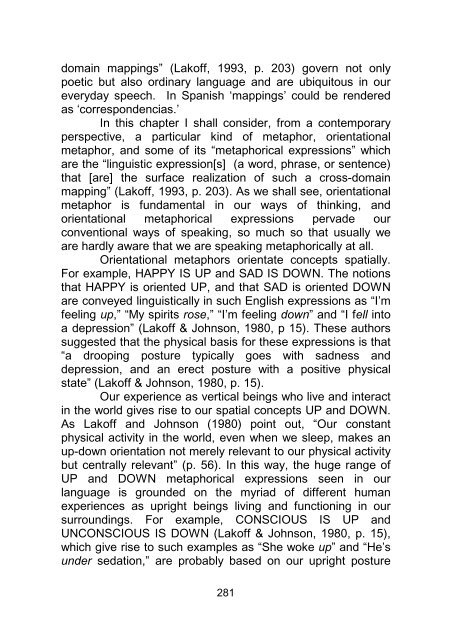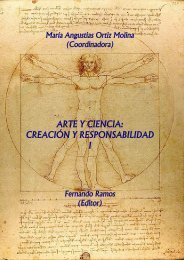- Page 1:
Fernando Sadio Ramos (Coord.) Diál
- Page 7 and 8:
Fernando Sadio Ramos (Coord.) Diál
- Page 9 and 10:
Índice Diálogo e Comunicação In
- Page 11:
Capítulo 13 Literacia e outros vec
- Page 14 and 15:
O Encontro de Primavera ® pretende
- Page 16 and 17:
da praxis e o império do pensament
- Page 18 and 19:
que le rodea para poder actuar en e
- Page 20 and 21:
las diferenciaciones culturales, po
- Page 22 and 23:
que incitaban a lo rítmico, a prod
- Page 24 and 25:
• He reiterado las alusiones al m
- Page 26 and 27:
funciona es por cuanto está interf
- Page 28 and 29:
llamada clásica que se desarrolla
- Page 30 and 31:
[Mucho más que por el estilo de m
- Page 32 and 33:
competencia intercultural tiene con
- Page 34 and 35:
o Tal acervo de obras musicales ha
- Page 36 and 37:
vinculación a sus propios compañe
- Page 39 and 40:
Capítulo 2 Valores, Educación Mus
- Page 41 and 42:
deberían adaptarse a nuestro prese
- Page 43 and 44:
unos a los otros, colaborando mutua
- Page 45 and 46:
valores pero no facilita su aprendi
- Page 47 and 48:
audiovisuales, el hilo musical… T
- Page 49 and 50:
el respeto por su realidad propia m
- Page 51 and 52:
adaptarse al ritmo de los demás -q
- Page 53 and 54:
PRINCIPALES VALORES ACTIVIDADES MUS
- Page 55:
- Torralba, Francesc. (2006). El ar
- Page 58 and 59:
deserto nietzscheano, crescem e pro
- Page 60 and 61:
de ‘história efectual’ 14 . A
- Page 62 and 63:
elementos essenciais originários d
- Page 64 and 65:
abandonar a Grécia, mas permanecer
- Page 66 and 67:
‘Educado no ethos da lei’, reza
- Page 68 and 69:
que agora entre todos os Aqueus dec
- Page 70 and 71:
dentro de su mismo esquema de funci
- Page 72:
Melilla y Ceuta las Consejerías de
- Page 75 and 76:
Por lo que se refiere a la contribu
- Page 77 and 78:
Al final de cada uno de los tres pe
- Page 79 and 80:
Segundo Periodo Lectivo Tercer Peri
- Page 81 and 82:
17.30 a 19 h. (Octubre a Mayo). INI
- Page 83 and 84:
O4. Los cuatro “evangelios” de
- Page 85 and 86:
2.2. Programa de Formación Extensi
- Page 87 and 88:
Marzo 2008: 4 11 Abril 2008: 1 8 15
- Page 89 and 90:
Continua. Los alumnos dispondrán d
- Page 91 and 92:
2º.- Expresión vocal y canto. 1.
- Page 93 and 94:
y el disfrute. Junto al canto, pued
- Page 95 and 96:
Referencias - A.A.V.V. (1971). The
- Page 97 and 98:
Capítulo 5 El envejecimiento. La m
- Page 99 and 100:
Existen una serie de estereotipos s
- Page 101 and 102:
Cada vez es más frecuente encontra
- Page 103 and 104:
La mujer mayor En la actualidad se
- Page 105 and 106:
las prestaciones que contempla supo
- Page 107 and 108:
querer caer en el estereotipo ni la
- Page 109 and 110:
que estaba íntegramente confeccion
- Page 111 and 112:
Las mujeres debían permanecer en l
- Page 113 and 114:
Capítulo 6 Educação para a Diver
- Page 115 and 116:
quer problema ou deficiência - pod
- Page 117 and 118:
vida social, familiar e laboral int
- Page 119 and 120:
liares na estruturação e na organ
- Page 121 and 122:
darem conta - já que a prática pe
- Page 123 and 124:
ções em inculcar determinados val
- Page 125 and 126:
Ano Autores Manual analisado Os out
- Page 127 and 128:
Estas constatações determinaram q
- Page 129 and 130:
do currículo. - Através de invisi
- Page 131 and 132:
assim, possível encontrar tais dis
- Page 133 and 134:
Em relação a uma inculcação rel
- Page 135 and 136:
quadros 5A e 5B. Relativamente aos
- Page 137 and 138:
pessoas invisuais num único dos ma
- Page 139 and 140:
Dada a forma como foi seleccionada
- Page 141 and 142:
Madrid: Editorial Cincel, S.A. - Jo
- Page 143 and 144:
- Roldão, M. C. (1995). O Estudo d
- Page 145 and 146:
Capítulo 7 Uma lição de Benny Go
- Page 147 and 148:
na improvisação (Birkett 1995). A
- Page 149 and 150:
mais modernos dessa época, como Ch
- Page 151 and 152:
consequentemente, levam à expansã
- Page 153 and 154:
Esta gravação tem uma organizaç
- Page 155 and 156:
de uma appoggiatura de ré-mib, pro
- Page 157 and 158:
improvisar sobre a sua melodia, pod
- Page 159 and 160:
as notas da melodia são frequentem
- Page 161 and 162:
- Sadie, Stanley (2001). “Goodman
- Page 163 and 164:
Capítulo 8 El desarrollo del ritmo
- Page 165 and 166:
La enseñanza del ritmo por medio d
- Page 167 and 168:
Estas actividades comienzan con la
- Page 169 and 170:
Tempo Posición de partida = 76 Sen
- Page 171 and 172:
ta_a ta ti-ti si-il sil - ti-ta-ti
- Page 173 and 174:
2 4 Por otra parte, también se pue
- Page 175 and 176:
2 4 2 4 2 4 2 4 ti-ti ta ta ta ta t
- Page 177 and 178:
http://musica.rediris.es/leeme/revi
- Page 179 and 180:
Voz ¿Cómo te llamas? Me llamo Rob
- Page 181 and 182:
2 4 2 4 2 4 2 4 2 4 2 4 Ejercicio 1
- Page 183 and 184:
Capítulo 9 Lenguaje y Música. Des
- Page 185 and 186:
ordenador cuál de las cuatro posib
- Page 187 and 188:
y la teoría de los esquemas de Man
- Page 189 and 190:
Puesto que parece existir una relac
- Page 191 and 192:
discriminar entre melodías y muest
- Page 193 and 194:
esencia, los resultados de este est
- Page 195 and 196:
destrezas musicales (Anvari et al.,
- Page 197 and 198:
Por otra parte, la regularidad rít
- Page 199 and 200:
otras posibles partes hubieran supu
- Page 201 and 202:
en este caso, consiste en decir el
- Page 203 and 204:
que escribir 10 veces la letra obje
- Page 205 and 206:
) Fonema /s/ COLIFLOR, COLCHÓN, PI
- Page 207 and 208:
todos los niños lo realizan bien s
- Page 209 and 210:
2. Ejemplo de canción para trabaja
- Page 211 and 212:
207
- Page 213 and 214:
5. Ejemplo de canción para trabaja
- Page 215 and 216:
7. 1. Ejemplo de canción para trab
- Page 217 and 218:
8. Ejemplo de canción para trabaja
- Page 219 and 220:
10. Ejemplo de canción para trabaj
- Page 221 and 222:
- Bradley, L. & Bryant, P.E. (1983)
- Page 223 and 224:
awareness with and without musical
- Page 225 and 226:
- Rodríguez, J.A. (1992). Aprendiz
- Page 227 and 228:
Capítulo 10 Da Música no âmbito
- Page 229 and 230:
Seguindo o exemplo das principais c
- Page 231 and 232:
Nos Quadros Históricos das Tres Ul
- Page 233 and 234: polifónica do século XIV) encontr
- Page 235 and 236: clérigo se nom souber o saltério
- Page 237 and 238: mestre escola, cujos nomes indica,
- Page 239 and 240: Sobre o Infante D. Fernando, diz-no
- Page 241 and 242: “hordinayro” de sua capela, um
- Page 243 and 244: Chronica afirma que o monarca «fol
- Page 245 and 246: Os passeios fluviais em Lisboa ou
- Page 247 and 248: João II «mandou que todalas moura
- Page 249 and 250: Que gram saber nos orgãos! E o Bae
- Page 251 and 252: mantinhão honradamente, e allem d
- Page 253 and 254: cerimónia, porém sem execução m
- Page 255 and 256: Que quiero dezir: que el libro esta
- Page 257 and 258: durável, assim como a utilização
- Page 259 and 260: primeiros capítulos, e sobretudo o
- Page 261 and 262: de 1919/1920, leccionada pela prime
- Page 263 and 264: no Arquivo da Universidade de Coimb
- Page 265 and 266: Capítulo 11 Cifras de los principi
- Page 267 and 268: dos terceros hablaron solo unas pal
- Page 269 and 270: modelo trascendental no sólo para
- Page 271 and 272: con el formato de la prueba. No obs
- Page 273 and 274: Tabla 1: Estadísticas para el Perc
- Page 275 and 276: Tabla 3: Estadísticas para la Perc
- Page 277 and 278: p < .0001. (véase la Tabla 5). Tod
- Page 279 and 280: campo del aprendizaje del inglés c
- Page 281 and 282: - Lynch, Andrew. (1996). The relati
- Page 283: Capítulo 12 Todo está en el aire
- Page 287 and 288: TARGET DOMAIN IS SOURCE DOMAIN HAPP
- Page 289 and 290: Matters came to a head. He’s feel
- Page 291 and 292: are conveyed in this vertically spa
- Page 293 and 294: Europe at least, with its fleeting
- Page 295 and 296: Things are looking up. His spirits
- Page 297 and 298: THE UNKNOWN IS UP; KNOWLEDGE IS DOW
- Page 299 and 300: often UP. Things that are hidden or
- Page 301 and 302: Future events, like objects, appear
- Page 303 and 304: Capítulo 13 Literacia e outros vec
- Page 305 and 306: e da leitura e só quando podemos f
- Page 307 and 308: habitadas pelas ideias de abertura,
- Page 309 and 310: Face ao exposto, consideramos perti
- Page 311 and 312: desenhos e outros grafismos visuais
- Page 313 and 314: Uma das dimensões da obra de Munar
- Page 315 and 316: Um primeiro movimento em defesa da
- Page 317 and 318: tenham durante largo tempo permanec
- Page 319 and 320: expectativa de uma revelação, um
- Page 321 and 322: que é reconhecidamente uma forma d
- Page 323 and 324: pinta e que, ao pintar-se, descobre
- Page 325 and 326: mais portátil, tornava-se um instr
- Page 327 and 328: aproximou - assim nos afastando - d
- Page 329 and 330: Mas o olhar inteligente (a relaçã
- Page 331 and 332: Tocados pelas imagens, indiferentes
- Page 333 and 334: - Piaget, Jean (1969) - Psychologie
- Page 335 and 336:
Capítulo 14 Video Production in Hi
- Page 337 and 338:
- “Coherence”; - “Colour temp
- Page 339 and 340:
B) Camera 1 - Television Storytelli
- Page 341 and 342:
female and/or riches)”(Id.). But
- Page 343 and 344:
2 - Narrator as an Investigator - h
- Page 345 and 346:
3 - Camera Shots - The usage of the
- Page 347 and 348:
3.3 - Camera Angles xi The angulati
- Page 349 and 350:
so a good narrative is possible is
- Page 351 and 352:
Image 6 - ProShowGold (source: www.
- Page 353 and 354:
Regarding this issue, we cam also s
- Page 355 and 356:
videos are embedded in the blog’s
- Page 357 and 358:
- Aristotle's Poetics (adapted from
- Page 359 and 360:
http://papers.ssrn.com/sol3/cf_dev/
- Page 361 and 362:
Capítulo 15 Pedro e Inês na Liter
- Page 363 and 364:
processo desencadeia-se particularm
- Page 365 and 366:
não infantilização do leitor. As
- Page 367 and 368:
Acaso sabeis de que cor é a tinta
- Page 369 and 370:
conflitos interiores de D. Pedro e
- Page 371 and 372:
Foi numa tarde de chuva num centro
- Page 373 and 374:
Capítulo 16 Se Chovesse Vocês Est
- Page 375 and 376:
mesmo, vó. (Lembra do Avô) E o se
- Page 377 and 378:
matérias selecionadas, à maneira
- Page 379 and 380:
Professora - Mas o que eu quero é
- Page 381 and 382:
Aluno - Viram só? Bonito, não é?
- Page 383 and 384:
Professora - Não se pode comer pei
- Page 385 and 386:
duvidaram do barbarismo dos bárbar
- Page 387 and 388:
em-aventurança. Os professores vir
- Page 389 and 390:
Capítulo 17 Projecto para a promo
- Page 391 and 392:
Erasmus na nossa Escola - e a discu
- Page 393 and 394:
Como é que a Expressão Dramática
- Page 395 and 396:
O que é que a Expressão Dramátic
- Page 397 and 398:
físico, mental, vocal, dependendo
- Page 399 and 400:
Exploração Interiorização Ret
- Page 401 and 402:
depende de condições externas, co
- Page 403 and 404:
consciência corporal é importante
- Page 405 and 406:
Seguidamente podia inserir-se a fas
- Page 408:
Composição Fernando Sadio Ramos I








